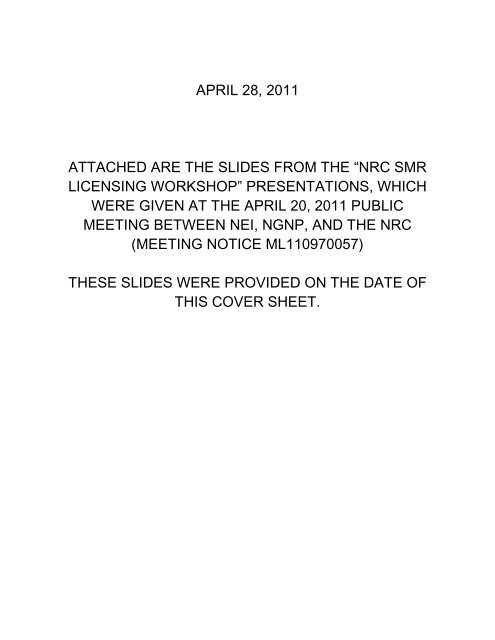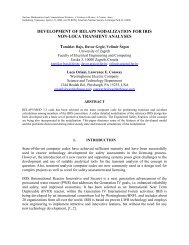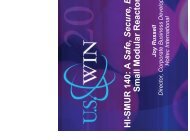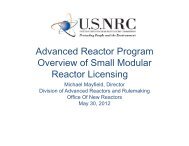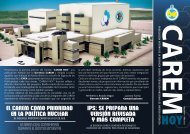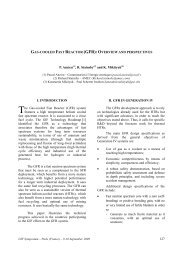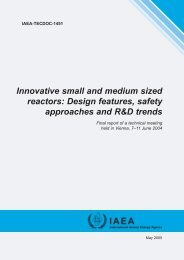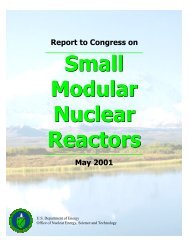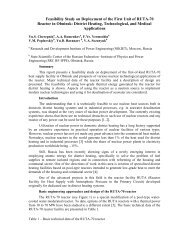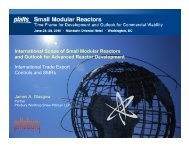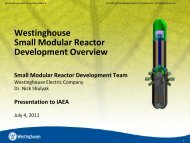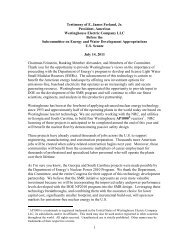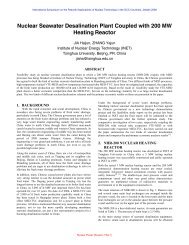Status of Generic Issues Related to SMR Licensing - NRC
Status of Generic Issues Related to SMR Licensing - NRC
Status of Generic Issues Related to SMR Licensing - NRC
You also want an ePaper? Increase the reach of your titles
YUMPU automatically turns print PDFs into web optimized ePapers that Google loves.
APRIL 28, 2011ATTACHED ARE THE SLIDES FROM THE “<strong>NRC</strong> <strong>SMR</strong>LICENSING WORKSHOP” PRESENTATIONS, WHICHWERE GIVEN AT THE APRIL 20, 2011 PUBLICMEETING BETWEEN NEI, NGNP, AND THE <strong>NRC</strong>(MEETING NOTICE ML110970057)THESE SLIDES WERE PROVIDED ON THE DATE OFTHIS COVER SHEET.
<strong>Status</strong> <strong>of</strong> <strong>Generic</strong> <strong>Issues</strong><strong>Related</strong> <strong>to</strong> <strong>SMR</strong> <strong>Licensing</strong><strong>NRC</strong> <strong>SMR</strong> <strong>Licensing</strong> WorkshopApril 20, 2011
Overview• NEI <strong>SMR</strong> <strong>Licensing</strong> Task Force engaged in effort <strong>to</strong>develop position papers on multiple generic licensingissues– Four industry position papers submitted since November2010– Another industry position paper forthcoming in near future– Three industry position papers slated for completion by mid-2011• Newly-formed <strong>SMR</strong> Working Group and <strong>SMR</strong> OversightCommittee giving guidance on position paperdevelopment
Completed Position Papers• <strong>NRC</strong> Annual Fees (November 2010)• Decommissioning Funding (November2010)• License Structure for Multi-ModuleFacilities (December 2010)• Pre-Application Engagement (January2011)
Near-Term Position Papers• Price-Anderson Liability Insurance– Evaluates implications and interpretation <strong>of</strong>current statute and <strong>NRC</strong> regulations– Includes input from insurers, vendors, andutilities– Preliminary conclusions <strong>to</strong> be discussed later<strong>to</strong>day– Anticipated completion <strong>of</strong> paper by mid-May
Position Papers Under Developmentfor Mid-2011 Submittal• Security design and staffing• Control room staffing• Modularity and source terms
Security Design and Staffing• Team is actively evaluating current requirements– Application <strong>of</strong> advanced technology– Cyber security– Aircraft impact– Staffing– Footprint/DBT considerations– Integrated approaches• Will evaluate potential approaches <strong>to</strong> creditingadvanced technology <strong>to</strong> meet current requirements• Intend <strong>to</strong> functionally satisfy current requirements
Control Room Staffing• Identified as high priority per directionfrom <strong>SMR</strong> Working Group and <strong>SMR</strong>Oversight Committee• Will evaluate approaches <strong>to</strong> determiningappropriate control room staffing levels for<strong>SMR</strong>s• Plan <strong>to</strong> engage with <strong>NRC</strong> staff as SECY onstaffing is developed
Modularity and Source Terms• Focus <strong>of</strong> paper will be generic• Intent is <strong>to</strong> provide high-level approachapplicable <strong>to</strong>– iPWRs– Non-LWRs• Appropriate consideration <strong>of</strong>– Design specific features– Delayed and reduced releases– <strong>SMR</strong>-specific accident scenario considerations
Summary• Four position papers submitted <strong>to</strong> date• One more near-term submittals scheduled• New NEI <strong>SMR</strong> Working Group and <strong>SMR</strong> OversightCommittee are providing executive input ondirection <strong>of</strong> activities• NEI <strong>SMR</strong> <strong>Licensing</strong> Task Force planningadditional papers <strong>to</strong> be completed by mid-2011• Industry looks forward <strong>to</strong> <strong>NRC</strong> feedback on allposition papers
PRA Lessons Learned<strong>NRC</strong> <strong>SMR</strong> <strong>Licensing</strong> WorkshopApril 20, 2011
Overview• Guiding principles• Scope <strong>of</strong> evaluation• Schedule considerations• Useful <strong>to</strong>ols and processes• Best practices• Key lessons learned
Guiding Principles• Consider high-level Commission policy– Policy statements• Safety goal policy statement• PRA policy statement• Severe accident policy statement– Quantitative Health Objectives• Maintain perspective on projected uses <strong>of</strong> riskinformation– <strong>Licensing</strong>– Operations• Applications (e.g. RG 1.174)• Reac<strong>to</strong>r Oversight Process
Scope <strong>of</strong> Evaluation• Important <strong>to</strong> define and document early on• Review potential issues with currentframework– Recognize evolving use <strong>of</strong> risk-informedprocesses– Consideration <strong>of</strong> risk metrics– Review possible gaps in current processes• Clearly define which initia<strong>to</strong>rs and modes arewithin scope• Stay within defined scope
Schedule Considerations• Anticipated Commission involvement• PRA technical adequacy expectations– Clear description <strong>of</strong> expectations• Scope• Level <strong>of</strong> detail– Projected standards development schedule• Availability <strong>of</strong> methods• Implementation• Need for information in decision-making processes– <strong>Licensing</strong>– Applications– Standard Review Plan and other major document updates
Useful Tools and Processes• Interim Staff Guidance documents can beused <strong>to</strong> describe staff positions early on• Thorough reviews <strong>of</strong> Regula<strong>to</strong>ry Guideupdate schedules• Description <strong>of</strong> clear options can help guidediscussion• Table<strong>to</strong>p exercises can demonstrate realimpact <strong>of</strong> proposed options
Best Practices• Begin evaluation process early on• Develop clear options– Facilitate productive discussions withstakeholders– Propose path forward• Regular engagement with stakeholders iskey
Key Lessons Learned• Consider interface between differentdecisions being sought• Closely evaluate real impact on programsand processes• Conduct table<strong>to</strong>p pilots early on• Maintain perspective on all components <strong>of</strong>risk informed decision making process
<strong>SMR</strong> Nuclear Insurance PositionPaper Update<strong>NRC</strong> <strong>SMR</strong> <strong>Licensing</strong> PublicWorkshopApril 20, 2011
<strong>SMR</strong> Financial Protection:Terminology• Price-Anderson Act describes financial protectionrequirements for <strong>NRC</strong> “licensees” and <strong>NRC</strong> licensedreac<strong>to</strong>r “facilities”• Statute uses rated electrical capacity as a descrip<strong>to</strong>r• Statute and <strong>NRC</strong> regulations address areas relevant<strong>to</strong> <strong>SMR</strong>s– Combination <strong>of</strong> 2 or more facilities located at a single site– Each having a rated capacity between 100 and 300 MWe– Combined rated capacity <strong>of</strong> no more than 1300 MWe– Also addresses reac<strong>to</strong>rs with rated capacities <strong>of</strong> less than100 MWe19
<strong>SMR</strong> Financial Protection:Issue Description• <strong>SMR</strong> industry initial position− Unique design features may lower the potentialliabilities associated with <strong>SMR</strong>s− Some statu<strong>to</strong>ry and regula<strong>to</strong>ry requirements fornuclear power reac<strong>to</strong>rs – such as financialprotection and insurance provisions – may notappropriately reflect this difference− The current legal and regula<strong>to</strong>ry framework for<strong>SMR</strong> financial protection may result inunwarranted financial burdens and “overinsurance”<strong>of</strong> <strong>SMR</strong>s20
<strong>SMR</strong> Financial Protection:Position Paper Approach• SECY-10-0034: <strong>SMR</strong> financial insurance issuesmay warrant Commission consideration• An NEI-led industry group (subset <strong>of</strong> NEI <strong>SMR</strong><strong>Licensing</strong> Task Force) evaluated financialprotection provisions in Price-Anderson Act and<strong>NRC</strong> regulations relating <strong>to</strong> <strong>SMR</strong>s• Working group on financial protectionrequirements includes NEI staff, <strong>SMR</strong> vendors,potential utility users and nuclear insuranceproviders21
Industry Involvement in Evaluation• Ensures that diverse needs in this area will beaddressed by paper• <strong>SMR</strong> Vendors− B&W− GE-Hitachi− Hyperion− NuScale− Westinghouse• Utilities− Duke− Southern− SCE− TVA• Nuclear Insurers− ANI22
<strong>SMR</strong> Financial Protection:Position Paper Approach• 3Q 2010: Industry working groupsummarized current financial protectionprovisions, including those applicable <strong>to</strong><strong>SMR</strong>s, in the Price-Anderson Act and <strong>NRC</strong>regulations (10 CFR Part 140)− Liability insurance protection− Property insurance− Provisions relevant <strong>to</strong> <strong>SMR</strong>s− Basis for current requirements includes largeLWRs, small reac<strong>to</strong>rs, research/test reac<strong>to</strong>rs23
<strong>SMR</strong> Financial Protection:Position Paper Approach• 1Q 2011: Industry working group comparedcurrent financial protection requirements for<strong>SMR</strong>s and evaluated range <strong>of</strong> potential changes– NEI-led effort with appreciable <strong>SMR</strong> communityparticipation– Industry and <strong>NRC</strong> expertise on the Price-Anderson Actand <strong>NRC</strong> financial protection requirements wasobtained <strong>to</strong> further inform industry’s proposals– Current reac<strong>to</strong>r licensees <strong>of</strong>fered perspectives onimplementation <strong>of</strong> requirements for existing fleet– Evaluated premium structures as they may apply <strong>to</strong>envisioned <strong>SMR</strong> deployment strategies24
Questions Addressed by <strong>SMR</strong> FinancialProtection Position Paper• Changes needed <strong>to</strong> support <strong>SMR</strong>deployment, if any– Statu<strong>to</strong>ry (if applicable)– Regula<strong>to</strong>ry (if applicable)•Potential use <strong>of</strong> exemption process•Guidance development• Treatment <strong>of</strong> non-electric applications25
<strong>SMR</strong> Financial Protection:Preliminary Position Paper Conclusions• Existing financial protection requirementsadequately address <strong>SMR</strong>-specific considerations– Sufficiently flexible <strong>to</strong> accommodate proposed <strong>SMR</strong>designs– Statu<strong>to</strong>ry thresholds create potential inequalities inrequirements for some single-unit deployments– Based on current information, existing requirementsdo not pose obstacles <strong>to</strong> commercialization <strong>of</strong> <strong>SMR</strong>s• May need <strong>to</strong> reassess requirements (e.g., for nonelectricity-generatingreac<strong>to</strong>rs) if vendor interestmaterializes27


